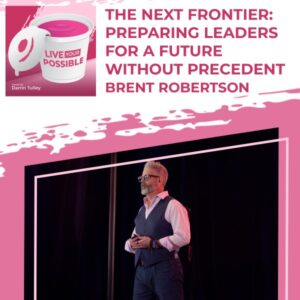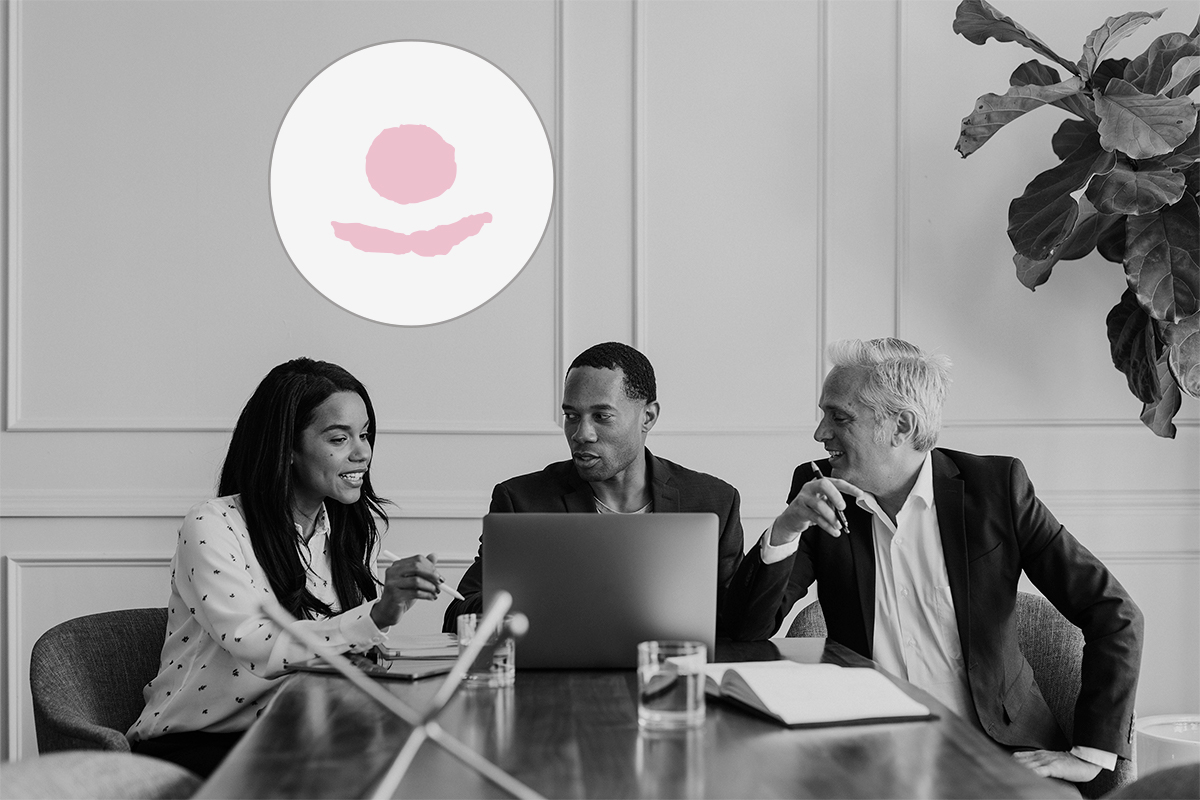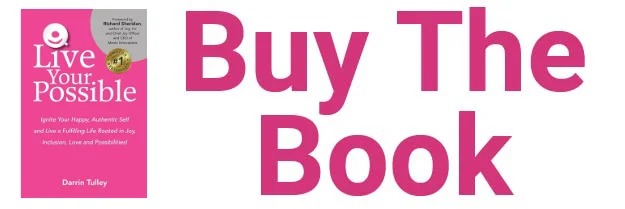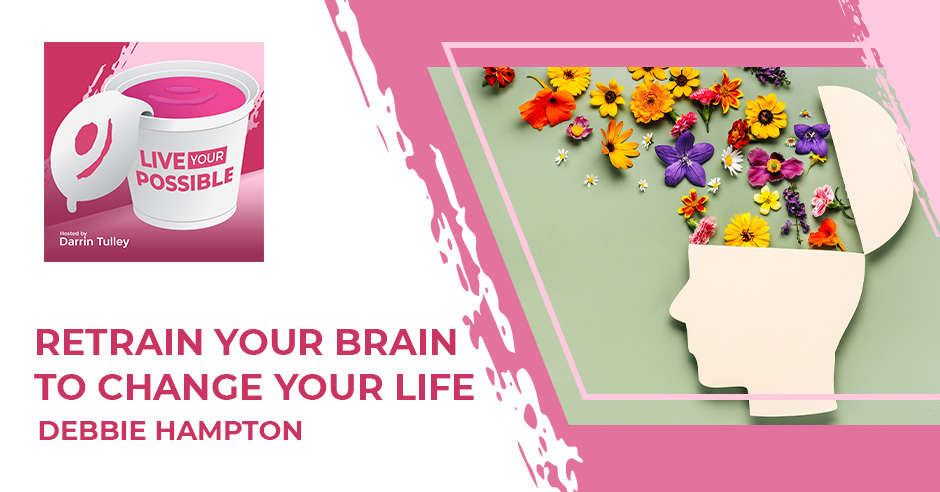
We tend to lose the harness when anxiety and depression take over our minds. The solution to overcoming depression and anxiety and stopping living in fear is in our heads. Debbie Hampton, the Author of Beat Depression and Anxiety by Changing Your Brain, shares her science-based research to retrain our brains to beat depression and enhance happiness. It is possible to change our brain because it’s not fixed and can grow until we die. The possibility of its change lies in our conscious effort to create a new habit and norm, leading to a healthier life. You can quickly learn the steps in her book, which she gives us a sneak peek at in this conversation. So stop holding back, take the harness, and tune in to slay the dragons inhabiting our brains.
—
Watch the episode here
Listen to the podcast here
Retrain Your Brain To Change Your Life With Debbie Hampton
Our guest is Debbie Hampton, an author and educational writer. She recovered from decades of unhealthy thinking and depression, a suicide attempt, and a resulting brain injury to become an inspirational, educational writer on the brain, psychological, emotional, and mental health issues for Huffington Post, MindBodyGreen, and more.
On her website, The Best Brain Possible, Debbie shares how she rebuilt her brain in life to find joy and thrive again. She wants you to know that you can do it too. You can quickly learn from the steps to a better you in her book Beat Depression and Anxiety by Changing Your Brain: With Simple Practices That Will Improve Your Life.
On the show, Debbie talks about her science-based research and how we could retrain our brains to reduce depression and enhance happiness. She is living proof of what can happen when you are regaining brain control on an intentional path with actions. Debbie overcame suicide attempts to experience her a-ha moment to connect with her instincts to want to live her life.
For anyone in distress or has a thought of suicide, contact the 988 Suicide and Crisis line, which provides 24/7 free, confidential support, or connect with a psychotherapist professional to help you. For the show, I invite you to tune in to the entire episode and learn how our brain works and how it will grow if we intentionally feed it.
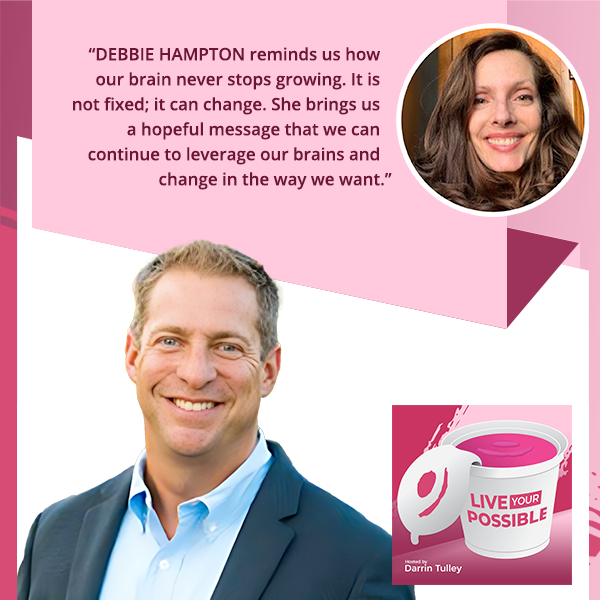
Debbie, welcome to the show. I’m excited to have you here. You are such an inspiration. You have been a big part of my book. You were featured in one of the chapters as we think about change and growth, in particular, with our brains. Your story is incredible, and how you have gotten to this point. I love to talk about that.
Thank you, Darrin. I’m happy to be here.
I appreciate your willingness to share all your knowledge and what you have learned and been through. Let’s jump right into it. Could you give us a little bit of background about how you got to this point about being such a brain expert?
That is a long story, but I will try to give you the Cliff Notes version. I grew up in a typical family in the ‘60s and ‘70s. I had educated middle-class parents who had good intentions, but as was typical at that time, I did not learn emotional intelligence or mental health skills. Our brains learn the environments that we grow up in. They model what we see. I learned how to be reactive and think catastrophically in ways that lead to depression. In other words, I had no coping skills.
I married my high school sweetheart. We went through college together. That became a codependent, narcissistic unhealthy relationship. I was married for eighteen years. We moved eleven times during that eighteen years. I’m in the States to follow his job. As he climbed the corporate ladder and gained success and power, I shrunk. I became smaller, more co-defense, and less confident in myself. I had two sons. I became a stay-at-home mother, which, as any stay-at-home mother knows, is an important job, but it is sheltering, isolating, and demanding. I also took care of my brother for two years. I was his caretaker who died of AIDS in the first AIDS epidemic in the ‘90s.
All of this is to say my mental health, which wasn’t great to begin with, I didn’t have any coping skills. I went downhill from life events and from my lack of ability to cope and respond in healthy ways or get help for myself. As is typical, brains aren’t born depressed. Depression is a thinking pattern that your brain learns. My brain learned it through patterns that I emulated in childhood. Through the series of events that happened, I became more depressed.
Brains aren't born depressed. Depression is a thinking pattern that your brain learns. Share on XIt is a self-fulfilling feedback loop. You reinforce the pattern in your brain with different behaviors and thoughts, and you become more depressed. As I had seen in my childhood with family members, one way to cope with challenging life events is to end your life. I attempted to end my life. One time, I was living in Florida. My sons were little. I didn’t do much damage. The ex-husband filed a restraining order against me. There were some other repercussions, but eventually, we got back together, and I put my life back together.
I tried again about five years later after the ex-husband and I had gotten divorced at my doing. Even when it is your doing, it is traumatic. I was a single mother of two. My boys were 9 and 13 at that time. I’m living alone in North Carolina. I moved back up here to be with my family. My initial reaction to getting divorced was to find another man because I had no value in myself. My value was always in a man.
He wasn’t much better than my first husband. He was a little bit narcissistic but emotionally abusive. When he broke up with me again, I decided this thing I could do was end my life. At that point, I had such a low opinion of myself. I felt like I was doing my sons a favor because I had heard people say, “How could you do that to your sons?” You have to understand that when somebody is that low and has that low and opinion of themselves, they don’t think they are doing anybody any good. This time, I tried to end my life and I always succeeded.
I put myself in a coma. I was in a coma for a week. When I woke up from the coma, I was severely brain injured. I couldn’t speak. I had almost no memory. I was severely impaired. I knew that a chair was a chair and a bed was a bed, but my brain couldn’t put the disparate parts of what I had seen together and make sense of it. I didn’t know I got divorced. I didn’t know my brother had died. It is like my brain went back to a time before all the pain and suffering. Immediately after the brain injury, my ex-husband sued me for custody of my sons and won and moved out of state with them. Here I am. I couldn’t speak. I had no short-term memory. My sons went to live with their dad in another state. I thought things were bad before. It was so bad that I wanted to end my life.
I had an a-ha moment when my other brother took me to Hawaii six months after the brain injury because he knew I needed something to look forward to and something good in my life. We went to Hawaii. The first day we were there, we went snorkeling. I was a good swimmer. I was a competitive swimmer all during my childhood. I was a lifeguard all through high school and college. We put on a snorkel and fins. We swam around this little bay in Hawaii. The bay opened out into the ocean. Where it opened up, the waves and currents were strong.
I was up there at the lip where it opened up. My fin kicked some lava rock under the water. It kicked my fin off. It was life or death. I didn’t have the physical coordination I used to have because of the brain injury. I was gulping water, going under it, and yelling, “Help.” My brother saw me, ran, and said, “Stay there.” I made it over to a lava rock sticking out of the water. If you know, they are covered with coral which cuts you. He was like, “Stay there. I’m going to get your sand shoes and a towel.”
I saw a little sailboat bobbing out in the middle of the day. I thought it was a better idea for me to try to swim in the sailboat. I was able to swim to the sailboat. I hung on the side of the boat, yelling for help. A guy came up above board and looked like he maybe thought he was hallucinating or wasn’t sure what he was seeing was true. He got a little boat and rode me to shore. The least to say I never went snorkeling again the whole time we were there, but it was a valuable experience.
It wasn’t until I got home that I realized, six months before that, I had tried to end my life intentionally. Here I was faced with a life-or-death situation, and I fought hard to live. That made me realize that my instinct was to live, and I wanted to live. All that stuff in my head that told me, “I wasn’t good enough. I wasn’t a good enough mother. I needed to end my life.” It was the chatter in my head. It wasn’t me.
It may sound ignorant, but that was the first time I ever realized that what was going on in my head wasn’t me. I decided from that point on, I wanted to live and started acting like it. I started seeking out and learning everything I could about rehabilitating my brain and body emotionally, physically, and spiritually. It did take 3 to 5 years before I even got to where life was normal again.
What I did was read and educate myself about the brain. One of the first books that will help anybody understand is Norman Doidge’s book The Brain That Changes Itself. It is a book about people born with half a brain or people that had strokes or horrible brain injuries and how they recovered. It is about how the brain grows and is resilient and how your brain is shaped.
After reading that, I thought, “Here is a manual on how to heal my brain.” Every brain in every brain injury or brain condition, whether it is depression, anxiety, ADHD, or whatever you want to correct, is different, but the basic premise is the same. It is called neuroplasticity. That means your brain changes. They used to think it changed when we were kids, but now we know your brain changes from birth to death. Physically, it changes its form, function, and operational patterns based on input. That is why I was saying, “I learned as a child to be reactive, dramatic, and emotional.” That’s how my brain formed.
Your brain and every one of us brains was shaped by our circumstances and environments when we were young because that is when the brain is like a sponge. It is soaking up everything. When you are older, it takes intentional effort to change your brain. You have to become aware of how your brain is operating and what beliefs, behavior patterns, and reactive patterns are already established. You then decide consciously to change them. You start changing them.
I’m not special. Any of us can do that. I like to say it is like Dorothy in Wizard of Oz. She had the red slippers that could take her home the whole time. We all have the ability to change our lives and brains. We have to know how to use it. It is called neuroplasticity. We all can use it to make our brains and our lives better.
It’s such a powerful story and so inspirational, Debbie. There are many things I would love to dig into. I love the fact that we can change. That is something I was not fully aware of until I started to read your work and understand your story. It was helpful for me as I often try to get folks to live their possible. I’m trying to get folks to understand we can rewire and do different things. It is got to be intentional. You are living proof of this in many ways.
Let’s go back to when you were in the hospital. I understand you had to reteach and relearn how to breathe, figure out how to talk, walk, and some of the basics in life. How did you have it in you at that point to relearn? Was that instinctual again? How did that go? How did you make progress over those six months before you went out to Hawaii?
As a matter of fact, I had another plan to end my life. It wasn’t until that experience in Hawaii that I realized that I had a lot to live for and that my brain had been convincing me that I wanted to die. I had been torturing myself with the images of my brother dying and taking care of him through the AIDS ordeal and the images of my ex-husband’s lawyer in the courtroom saying horrible things about me. That is her job. They are in a courtroom saying all these things in front of all their family and friends.
I have no doubt that I had PTSD, but I also had negative thinking patterns and habits, which reinforced these things day after day and played them over and over in my brain. When we do that, what we are doing is making those connections stronger in our brains. You get more of the same. I don’t mean to say it is easy. Rewiring my brain and changing my behavior and thinking patterns took years.
Some things are quick and quicker and some things may never change. I’m still primarily an anxious person, but now, I have the tools to deal with anxiety, figure out what is happening, and not react based on my emotions. When you react to your emotions and live your life from that place, it is most often not going to turn up well. I’m convinced that the key to being able to control and guide our lives successfully is being able to control and guide our brains and ourselves. If we can do that, you are on the road to your goals, success, and happiness, much more so than anything else you could do.
What are some steps folks could start to think about to be intentional and unlearn some of the things that we’re putting in our minds to ease that so we could start to revisit new thinking, rewire habits, or be less depressed with all the things that you are mentioning?
Darrin, I finished a book on using mindfulness as a mental health tool. I know a lot of people think mindfulness is meditation or this airy fairy spiritual practice. It is not. I’m talking about becoming aware of your thoughts, coming into the present and realizing what you are thinking and how you are reacting, and stopping and taking control of that.
Our reactions, emotions, and impulses suffer programmed, but most come from your subconscious brain, and your limbus system is based on your fears and wounds because your brain’s first priority is always your safety. It does everything it can to protect and keep you away from anything that made you anxious or scared before. In this day and age, when we don’t get chased by lions, it holds us back because it keeps us small and afraid of going after the things that make us happy or the things that we want to achieve.
It is unrealistic to think you are ever not going to feel those feelings. That is your brain’s job. It is always going to have a negative bias and a knee-jerk reaction to things that make us scared. What you can do is become mindful. What you’re doing in your brain is moving the control of what is happening in your thoughts, mind, and behavior to your frontal lobe. The frontal lobe is our humanness and our superior intelligence.
When you move from the fear center, reacting to your frontal lobe, you can consider, “What is going to be in my best interest? How do I want to behave? What life do I want to build? Who do I want to be?” You can decide and act in a way that reinforces that. We talked about neuroplasticity. With repetition, time, and consistency, your brain will form new connections and rewire itself to reinforce those patterns. They may never be the default, but they can be the easier go-tos.

The default is based on what we have learned over time that we have formed, and we are rewiring another way of tapping into something we want to see more of. Is that the way to look at it? It doesn’t go away. We have this new opportunity to tap into this new way of thinking. For example, I’m looking to have more joy and happiness wherever I am in the community and workplace. I’m looking for that all the time. That is in my frontal lobe. I love how you said humanness because that is perfect. It almost allows us to truly connect in the world. Am I thinking about that the right way?
Yes, the default pathways we have when we arrive at young adulthood are formed by our environments, fears, and experiences that our brain takes note of. Your brain doesn’t keep track of or care about all the wonderful things that happened, but it is going to keep track of and remember all the bad things and all the things that scared you.
Your brain is wired that way. It is wired to avoid. It is not wired to approach, achieve, and get happy. Your brain knows all the bad. We have to consciously repave, remake those connections and pathways, look for good things, and create good things. I’m still anxious. My initial reaction is always going to be anxiety. I don’t want to ride that because you want to be able to react when you need to. You want your brain to be able to keep you safe when it needs to.
What I and anybody can learn to do is to stop and realize I’m having those feelings and insert intelligence and say, “That is my initial reaction because of my anxiety or fear from the past. What do I want to do? Even if it scares me, I want to go in a direction that terrifies me because I know it will be the biggest gain or growth for me.”
The whole point is to consciously live your life and not let your brain, instincts, and reflexes be in control because that is how I made a big mess of my life. It doesn’t mean that everything is rainbow and glitter once you become mindful. It means you are more equipped to handle life’s challenges. When stressors do show up, I can support and encourage myself with self-talk and choose what is going to be the path in my best interest and for my most gain, rather than wrapped, try to avoid and run away because that doesn’t get you anywhere.
It is limiting, especially the reaction, without the thought of being conscious and seeing what’s theirs, even the possibilities of what is good or what could be joyful. Could you extend this a little bit to say this can help our readers improve their own levels of happiness and reduce some of the negative aspects of depression? Does that reverse the course?
You can call it mindfulness. It is also called thought reframing or cognitive dissonance. There are all kinds of things you can call it, but let’s call it becoming aware and using your brain consciously. There are studies confirming that it calms your amygdala, that fear center in your brain. It can make you have a happier outlook. It can cure depressive symptoms. You can increase your focus and attention skills by doing this ADHD. It helps with PTSD. Almost any mental health or brain condition can benefit by mindfully and consciously becoming aware of and guiding your brain.
That is helpful and encouraging. I know you have several articles on your website. There are many different ways to think about how we could leverage our brain because it can change and grow. It is hopeful because we can change in the way we want. What do you think about this with how we view other people? No matter where we are, there is so much divisiveness and hatred. People are stuck in their ways. I don’t feel like people are reaching out to people in a human way, like using that humanness element that you talked about. How can this help us view other people differently and welcome the world in a different way?
It does make us more empathetic. It has made me personally more understanding because you realize that everybody is a product. Their brains are a product of their upbringing or environment. We all have the opportunity and responsibility at some point as adults to say, “I’m going to consciously choose who I am rather than just the way I am.”
There are scientific studies that show mindfulness and awareness increases empathy and decrease discrimination and bigotry. One of the main basics of mindfulness and meditation is finding the common humanness and suffering in humanity globally, not just humanity but all living beings. There is specific meditation called Loving-Kindness Meditation. You send out energy and receive energy from all living beings and wish all living beings kindness. It helps us realize we are not different. At the core, we all want the same things. We may express it differently.
We are all unique. There are many commonalities. That is a great way to think about it. Our commonalities are what connect us. Our difference is what makes us all unique and beautiful. I didn’t realize I was changing in this way with mindfulness from the standpoint that there is a beautiful light inside of all of us. There is this beautiful way and ability that we all bring. I limited myself to thinking to say, “Over time, certain people could do certain things.” I saw people differently based on the way I was taught. I had to recognize they needed to change.
Everything you are saying, I lived it too. I’m taking different steps intentionally to welcome every single human in my mind to say, “They have so much potential. They have a beautiful light. Let’s tap into that together and show people they can.” Using the skills and the tips you are providing is a great augmentation to help people thrive. It is fascinating. You have an article out there. You talked about some quirky elements of the brain. There were ten quirky elements that you shared in that article. Are there any that were of interest to you that pop into your mind?
The main one I want to stress is that your brain can change, not just me but everybody’s brain. It takes intentional effort to do it, but we all can change our brains. When you change your brain, you change your life, mental health, and even physical health. Did you know your brain produces enough electricity to power a light bulb?
It takes intentional effort to do it, but we all can change our brains. When you change your brain, you change your life, mental health, and even physical health. Share on XI recall seeing the effects of giving back to the world, providing levels of charity, and having certain experiences. How does that affect our brain?
Volunteering and acts of kindness are one way that you can alleviate depression symptoms because it allows our brain not to introspect too much and concentrate on our own problems and feelings. Giving back benefited the giver’s brain as well as the recipients. Our brains are social. We need other people to survive and be healthy. Interacting with others releases certain chemicals like serotonin and oxytocin that our brains need to stay happy and healthy. Volunteering and social interaction are one of the ways.
Depression and anxiety are encouraged by lifestyle habits. It is one of the ways we can discourage depression and anxiety. There is an epidemic of depression and anxiety, especially after the pandemic. I consider mental health a lifestyle. I exercise almost every day. I meditate. I eat a healthy diet most of the time. I try to get social interaction. I get enough sleep.
Being mentally healthy, feeling healthy and happy, a lot of time, is in your habits. You can reinforce that or reinforce being unhealthy. I certainly used to reinforce being unhealthy. I’m not saying I’m healthy all the time. I’m saying I know how to keep myself on track. If I get off track now, I know how to ride this ship and get back on course.
There are patterns here as we notice that we continue to do things that might be harmful to our bodies. I loved how you brought in exercise and food. We all say, “Yes, no kidding.” A lot of these elements of mental health and self-care are the things we are not doing. We know, but we are not taking intentional action. Everything you are saying is if we put these together, we have control of our brains.
I’m not anti-medication. Medication can help and is necessary in some circumstances, but you can’t take a pill and expect everything to be okay. You got to live a life that encourages health and happiness. That’s proven as well.
What is your take on manifesting in life? I have heard different speakers talk about, “If you put it out there, it could happen or does happen.” I feel like it is connected to your components and related to the front lobe. What is your take on the manifestation?
I’m not a big believer in the Law of Attraction. That is a universal vending machine. I don’t think you can think good thoughts or put the energy out there and things will materialize. You have to walk the walk, make decisions and put efforts into daily habits and actions that reinforce what you want. I did a blog, which I thought was interesting, on mindset. I’m research-based. Everything I’m saying is backed up by science. I don’t believe in just thinking positively.
Do you know what they said? The research said the biggest predictor of whether you are lucky or not is not random. The biggest predictor of luck is if you look for opportunities. I worked at a university. I fought for parking with all the students. I had gotten to the point where I would park at the flat stadium and walk five minutes to work because I got tired of driving around looking for a place. After I wrote that and read that, I said, “I’m going to look to see if I can find a parking space.” Four times out of five, I would find a space. What I was doing is I was automatically parking five minutes away. I wasn’t giving myself a chance to be lucky.
You got to take the action. You have to do the hard work sometimes or the work that will support something you are putting out there, an idea, a thought, or something you believe in. Believing something without action gets a little empty. It is walking the talk. I have to say this is impressive. The fact that you went from this dark place, you are shining as you are sharing your knowledge.
You are digging in, doing the work, and learning all the aspects of the brain, how it works, and how it can grow. I know you have a book coming out, which I’m excited to get into when that comes out. Let me know when that is available. I would love for you to talk a little bit about the two books that you have written (and are available).
I have one called Beat Depression and Anxiety By Changing Your Brain. That tells all about neuroplasticity and how to harness it to benefit you and your mental health. The comment I get most about that book is how simple it is to understand, and I put it in language terms. I like to say, “I have to put it in terms I can understand.” It is based on neuroscience, but it is not complicated.
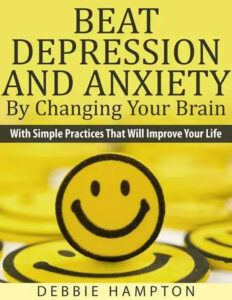
My second book is called Sex, Suicide, and Serotonin. It is my memoir about how I got to the place in life where I thought the answer was ending my life. It is about the attempt and the aftermath, where things got way worse before they got better. It was about how I rebuilt my brain, my life, and everything in my life. You don’t have to go to the extreme, hopefully, but all of us can do that. What it takes is the decision to do it and the daily effort.

It is wonderful you are sharing your story vulnerably and courageously. Are there any other things we should know about you? What do you do for fun? What do you do to keep yourself happy in other ways?
I’m pretty boring. I work a lot. For fun, I’m a big hot yogaholic. Do you know what hot yoga is?
Yes. I have done power yoga, which was a version of that because it hit me pretty good. It was intense.
This is yoga at 100 degrees and 40% humidity. It was an integral part of my healing journey, physically and mentally. I went on to own a yoga studio, which closed during COVID, but I’m still a hot yogaholic. I want to be one of those 100-year-old women doing yoga. I also have a garden that I eat out of all summer, and I have seven cats.
That will keep you busy. You lit up there with the seven cats. Pets make you happy.
They are my family. I love them. They are good cuddlers.
I’m happy to hear you are thinking about what it is going to look like at 100. You are living your life, and I’m happy for you. I’m sorry you have gone through what you have. Thanks for sharing your story. Hopefully, it will help some folks to think about things they can do to keep their life thriving and active and for many to figure out how we could rewire, retrace, rethink, and relearn. There is so much to live in this life that you are showing us is ahead. I want to ask one last question. Is there anything you want to give advice to or any other tips to our audience?
It is empowering to realize that we all have power already. We don’t have to spend money or find somebody with some expertise. We all have the power to change our brains and our lives. It is in what we do every single day. The small decisions you make now will determine the life and the brain you have in the future.
We all have the power to change our brains and our lives. It is in what we do every single day. The small decisions you make now will determine the life and the brain you have in the future. Share on XThank you. I love how all this is based on science and reality because you have lived this. Not only am I a believer, but I’m inspired. I’m grateful for you to be on the show. Debbie, thanks for sharing everything.
Thanks, Darrin. I enjoyed it.
—
Debbie’s story is such an inspiration. We can rewire our brains. What a relief to know this. However, it is not possible without being intentional and taking action. Changing habits takes time and good repetition, as Debbie pointed out. I went deeper into Debbie’s research and pulled out the following elements to help you believe you can also change.
The brain is not fixed. It can grow up until we die. Breaking a habit requires a change in the brain. This change must be a conscious effort to become a new habit or norm. When we do this, we create more serotonin in our brains, leading to living healthier and being present to enable change. Debbie shows us that science reinforces that positive self-reflection helps significantly establish these new habits.
As you begin, don’t beat yourself up. Commit to improving. Lastly, find people who encourage you, want to help you see positive change, and are willing to change themselves. These are the steps I believed in and took with my friends and daily challenges that rewarded my thinking to see more expansively to welcome all the possibilities waiting to be noticed. With this commitment, you can be your happy, authentic self and live your possible. I am living proof of this, along with our guest, Debbie Hampton.
Important Links
- The Best Brain Possible
- Beat Depression and Anxiety by Changing Your Brain: With Simple Practices That Will Improve Your Life
- The Brain That Changes Itself
- Sex, Suicide, and Serotonin
- https://www.Facebook.com/BestBrainPossible/
- https://www.Amazon.com/dp/B09SBVC7LF
- Beat Depression and Anxiety by Changing Your Brain: With Simple Practices That Will Improve Your Life – Amazon
About Debbie Hampton
 Debbie Hampton recovered from decades of unhealthy thinking and depression, a suicide attempt, and resulting brain injury to become an inspirational and educational writer on brain, psychological, emotional, and mental health issues for Huffington Post, MindBodyGreen, and more. On her website, The Best Brain Possible, Debbie shares how she rebuilt her brain and life to find joy and thrive. She wants you to know that you can do it too! You can quickly learn the steps to a better you in her book, Beat Depression And Anxiety By Changing Your Brain, with simple practices easy to implement in your daily life. Improve your brain, improve your life.
Debbie Hampton recovered from decades of unhealthy thinking and depression, a suicide attempt, and resulting brain injury to become an inspirational and educational writer on brain, psychological, emotional, and mental health issues for Huffington Post, MindBodyGreen, and more. On her website, The Best Brain Possible, Debbie shares how she rebuilt her brain and life to find joy and thrive. She wants you to know that you can do it too! You can quickly learn the steps to a better you in her book, Beat Depression And Anxiety By Changing Your Brain, with simple practices easy to implement in your daily life. Improve your brain, improve your life.


